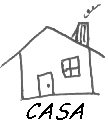 RETURN
HOME
RETURN
HOME
![]()
More Info!
The prison system here in Bolivia is difficult to imagine. For many from the western world the word 'prison' conjures up pictures of carpeted cells, color TV's, gymnasiums and libraries. In the US, for example, many prisoners study and earn degrees while serving time, others accept the fact that they are there and make the best of it. Now we're NOT trying to downplay the absence of freedom or other rights that any incarcerated person lacks, we're just trying to draw a contrast.
The system of prisons in Bolivia looks more like a cross between a Siberian concentration camp (as painted by Aleksandr Solzhenitsyn) and a Third World market place. The lack of freedom, overcrowding and absence of privacy all mix with the look and feel of a small (very small) open air market.
The San Sebastian Women's Prison here in Cochabamba sits on a
lot of 700 m2, that's about 8,000 square feet or an 80 X 100 foot
lot. There are three floors that open into a center courtyard. The
three floors contain rooms (very small cells) a couple sewing rooms,
a small chapel and a small medical clinic. Presently there are 380
women and 250 children living under these conditions.
There are several levels of accommodations in the prison:
Some women are forced to live out their days (and nights) on the open patio. This proves difficult if they have children as the patio shuts down at midnight or so and reopens at Am. While the patio is open the women who call it home must roll up their mattress, place all their belongings in a corner and move out of the way. Tough on the mom, tougher yet on the children.
The next level up from the patio is an open room about 25 X 30 feet. It houses 36 bunk beds. Most of the beds are separated by a sheet on one side and 15 inches on the other. Quite the lack of privacy, but a place to call their own.
Following the main room is the availability of a 'private room'. Of course private means that the women there may have between one and seven others in the room with them. The rooms are incredibly small, some of the beds no more than four and a half feet long.
Any of the given rooms are not free; each must be 'rented' for the duration of their time in prison. Since most of the women come to the prison poor, few have the opportunity of a 'first class' cell.
The women are pretty much on their own in regards to food. The
government provides water and electric plates to cook with, but the
inmates provide most of their food. They are very dependent on those
from the outside, friends or relatives, or must make a living from
the inside. Many can be seen working on craft materials: tablecloths,
vests, clothing, Etc. Others find more creative ways to earn money...
Outside the prison, life can be just as bad or worse for the
children. Since they are basically free to come and go, there is very
little control in their lives. The Women's prison opens into a
typical Latin American plaza. One side contains the Women's prison,
another the Men's prison, the third is one of the two major
'prostitution alleys' and the fourth opens up to the bus terminal and
main market place. The plaza is the home of prostitution activity,
gang hang-outs, glue sniffing youths and many other abhorrent
activities. It's certainly not the place for young girls to be
growing up.
In addition to working with the children of the prison, we are starting a discipleship program with the mothers there. It's imperative that when the women are released and their children return to them, that they have a foundation laid in Jesus Christ.
The ability to describe these scenes is nearly impossible for us. We honestly feel that the only way to get the picture is to visit.
It's the goal of Bolivian Youth Ministries to take girls from
this situation and provide them a caring, loving environment to grow
in while their mothers and/or fathers are incarcerated. The women at
San Sebastion are eager to have us accept their children as we've
quickly built a good reputation as a home that 'provides'. Our
sincere desire is that they are seeing the love of Jesus Christ
reflected off us.